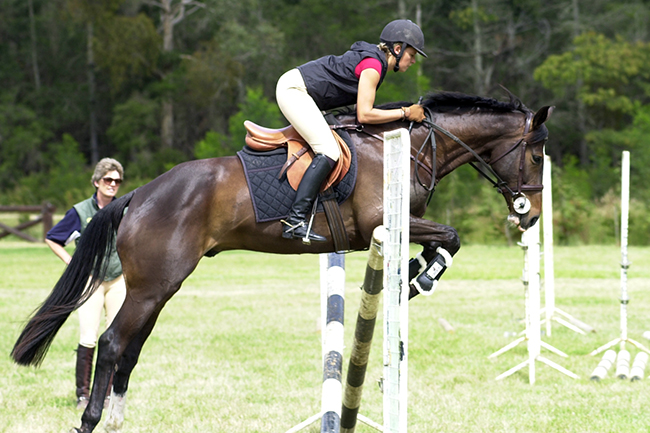 Words by Chris Hector and photos by Roz Neave
Words by Chris Hector and photos by Roz Neave
Olivia Dawson-Grove arrived for her lesson with Vicki Roycroft with a real baby, Honky Cat – just five years old, and just starting out.
Aside from the general greenness of her horse, Olivia confessed to having a tendency to desert her horse in front of the jump: “I tend to drop my shoulders in front of a fence, instead of riding them into my hand I desert them when I don’t see a stride.”
It’s a good analysis according to the teacher, Vicki Roycroft – but in truth there is no one stride to see. “The question is, which distance do you want? Up to a metre, metre twenty, there are five or six distances that can work, three lovely ones, and two that will still work. The problem is not the distance but the quality of the canter.”
“What you have to work on is the quality of the approach, and the quality of the depart, that’s the main thing. Come and go in a beautiful balance. That is the difference between ‘pure’ dressage and showjumping dressage. Pure dressage is always on the same size, same shaped arena whereas we are always working in different areas, our reactions have to be that much quicker.”
And showjumping dressage moves along very similar lines to every other sort of dressage…
“The first priority is that the horse moves away from your leg. He can’t accept your hand until he accepts your leg. First we want to get him going forward, nicely reacting to your leg, then try and get him better into hand.”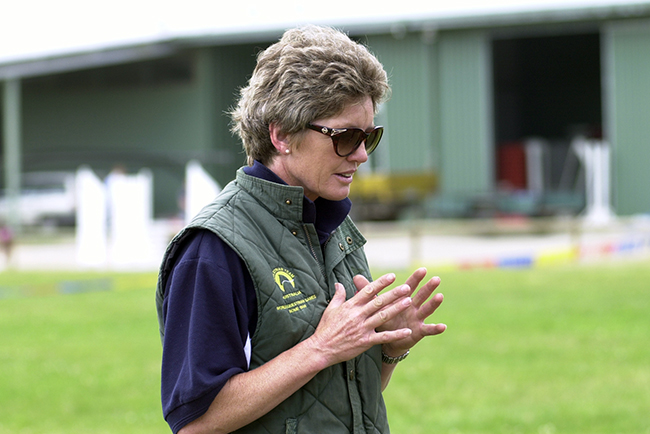
So they worked on a few circles, a few transitions, and then started work over a single pole on the ground…
“What we are working on is a straight approach. Let his nose come out a bit because you need him to be able to see the fence, let him look and figure out what he is doing. When you are working him away from the pole, change pace all the time. I am not an even pace person, a jumper has to be reactive. You think forward and he goes, think back, and he waits. It is a little bit hard for you to make him wait at this stage because he has the tendency to suck back on the bit.”
We move on to the cross bar, but the message is much the same:
“Eyes up, straight approach, straight depart, look at the fence, look at the line. When you land keep the canter forward, then half halt in the corner. When you land you tend to sit up into him. When he jumps you have this glorious big canter – try to keep that a little longer. Sure get your eyes up but keep that lovely canter, and use the corner to half halt and shorten him.”
“When you come in off that right corner, he is dropping his shoulder and drifting in … ”
And of course, Ms Roycroft can’t resist the temptation to have a sit. Once aboard her first exercise is to really get the horse round her inside leg, and giving to the hand:
“Any horse has to love your hand, has to accept your hand. It is far more natural for a horse to move off the inside leg. It is far harder for him to understand the outside leg, while still keeping the inside bend.”
“He’s like any young horse, when you make a half halt, he wants to dive on to his front end – that’s normal.”
And when he pokes out a rail, Vicki is not too concerned. “That’s good if he wants to make a mistake – that’s the only way they learn. Obviously he gets a bit uptight with a different rider on his back, and that is where you have to slow things down. With Warmbloods you have to sharpen them up, with Thoroughbreds, you have to slow things down. Franz Mairinger always said that the art of riding was to ride your pace, your direction, your line – and that is most important in our game because of the tracks we have to jump. Especially with young horses, I like lots of straight lines. Don’t let the horse decide when to make turns. When you are landing don’t try to force him to land on one leg or the other, ride a nice straight line, then turn.”
What is important in that last turn to the fence?
“Eyes”, says Olivia
After eyes, the next thing?
“Half halt.”
Vicki agrees: “You are balancing the horse. The half halt is not something mysterious, you don’t have to follow a set of rules, as long as you get the result. With a young horse you may have to use legs, seat, hands, with an educated horse, just your seat. With a jumping horse you do zillions of half halts.”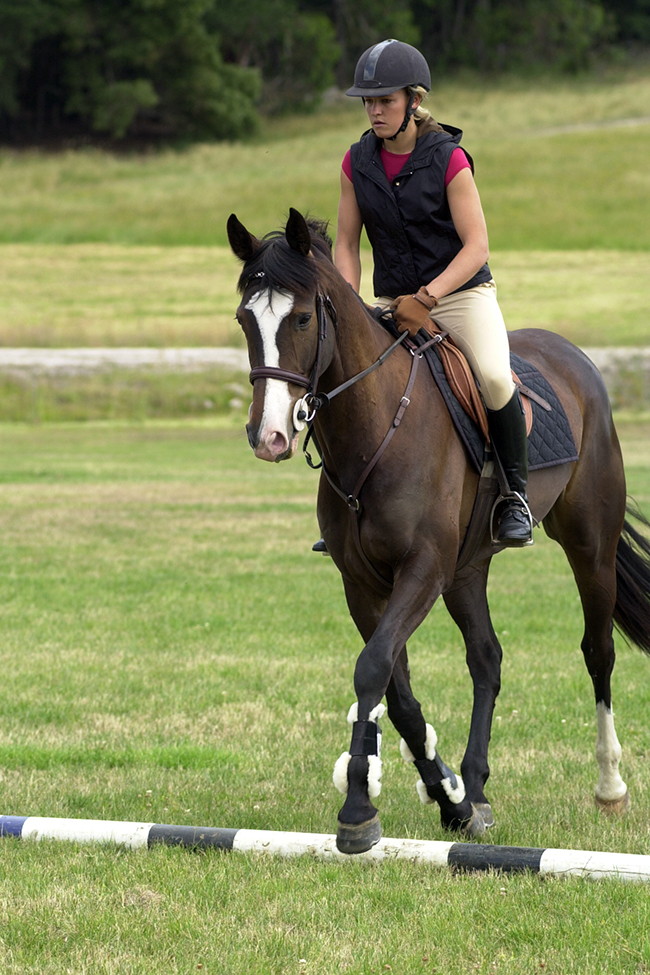
“Use your corners to help your half halts. You need to slow down enough going into the corner to be able to come out with a bit of power. Ride out of that corner with outside leg and outside rein. It’s amazing how many riders don’t think about corners – they just ride on the steering wheel, with their hands. Less hands, stiller hands, more riding with your leg but that doesn’t mean the horse doesn’t have to be submissive to the hands – but don’t try to drag the horse in, bend him and hold the bend, make him submissive that way. George Morris in a recent article in Chronicle of the Horse, talks about people always saying give and take, when it is really take and give.”
“What part of the body do the legs control? The hindquarters, later they influence the shoulders. The hands influence the head and neck. You must be able to separate the three parts of the horse’s body, and you must be able to bend his neck without the horse turning.”
And the horse was not neglected: “With a horse like this who is a bit dangly in front, work with a biggish ground line, give him time to get his knees up. Once we start to canter, then we have a whole new set of criteria. You’ve got to be careful with this horse, on most distances he tends to get in a little deep – and when we are schooling we usually want them to get deep, but with him, we want him to jump from a little further away, that is going to encourage him to bring his wither and shoulder up more. Don’t drag him in too deep every time.”
“Ninety percent of jumping is flat work. Riding fences with this guy is a bit tricky because the canter is still a bit strung out.”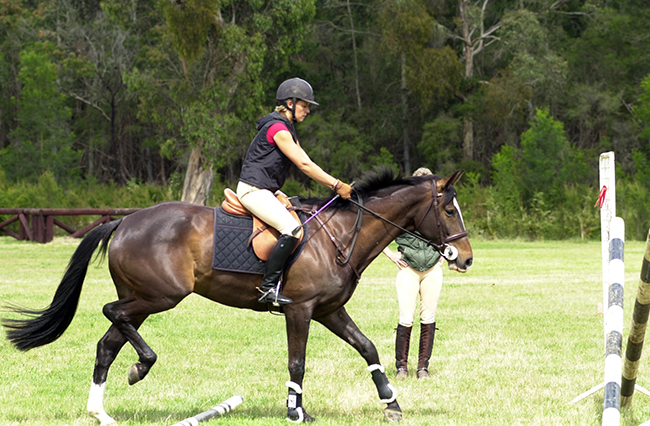
And the rider is still under stern scrutiny…
“Don’t lean forward and flap your elbows, Think more upper body than hands to make him wait, don’t help him with your hands too much, let him make a mistake. It’s hard because you don’t want him to jump totally over his front end. Stay in the middle of the horse, even if you have to stay back to correct him. In the ring by all means give him that little support off the ground, but when you are schooling, let him find his own way.”
By now, little Honky had had enough, time to put him away, time to reflect on the lesson. For Olivia, time to analyse…
“What did I get out of the lesson? Keeping him connected in the canter, not letting him fall off my leg, using lots of inside leg to get him bending and listening. He is still very young and green, so the lesson was what I expected in a way. I’ve never seen anyone else ride him, so it was good to see Vicki on him, and get her opinion. She reinforced everything that I need to do with him, which is good. She also worked a bit on my position which is what I really need to be doing now.”
You have been riding showjumping horses for a couple of years now – before that it was eventers, why the swap?
“Eventing gets a bit scary when the jumps get bigger and they don’t move. They don’t fall down – horses and riders seems to fall easier than the jumps do… I had a horse that was showjumping quite well, and the people I was involved with were more into showjumping.”
“I prefer showjumping now, I wouldn’t ever think about going back to eventing. I like the skill involved. Some people look at showjumping and think it is easy, but it’s not, just the skill involved to get them jumping round that course of ten or twelve jumps, to get them through the start flags and the finish flags, properly. People don’t realise how much flatwork is involved, but there’s heaps, once you get the flatwork going, they seem to jump well.”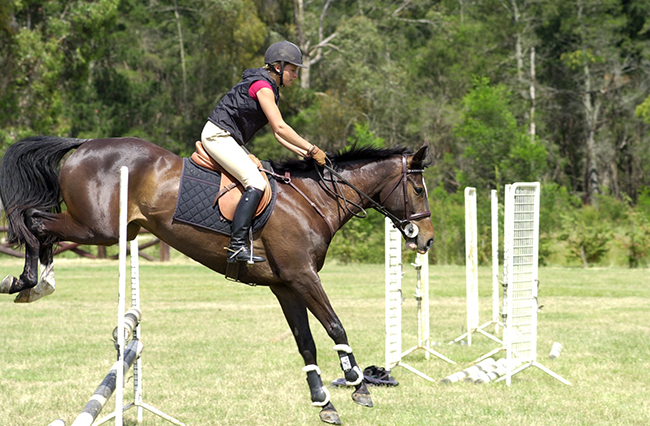
How many horses have you got in work?
“I’ve just got three – this one is the only one in work right now, the other two are on holidays, so that makes it easy. He was just broken in four weeks when I got him at the end of 1999. He’s by Majestic Supreme. He was a little bit difficult to begin with, but now he has really started to come to the party, he is starting to listen and behave himself a bit more. But I suppose it is like any young horse, they always play up a little bit. He’s the first horse I’ve had that I’ve started out just broken and taken up to competition stage. Everything the horse does, if it is right or wrong, I can only blame myself… any credit is mine alone, but if it goes wrong, then it’s my fault as well. It is a good feeling to be able to do it all yourself.”
Vicki sums it up:
“That lesson wasn’t exactly how I expected it. I thought we might be dealing with a horse with distance problems but her biggest problem was working with a young horse. It was a little hard to deal with Olivia because the horse is a very green five-year-old. Very sweet, but I couldn’t do a lot with her problems. Her biggest problem was getting the canter, but it is not something you do in a great big rush because it is only a baby. We did things like try to improve the canter/trot transitions.”
“Okay Olivia tips her body, which is a fault she is aware of. More important is to make her aware of her aids, and the use of her aids. That’s the biggest thing I find with all riders. They have very little perception of the aids, which are the most influential aids. They have problems with basic things, like how to turn a corner.”
“I watch Wayne teach someone, and he says ‘do a shoulder-in’. Okay they do a passable shoulder-in, but I say to him do they really know how to do a shoulder-in. If you ask them, half the time they can’t tell you how they did it. ”
“Often then I will say to them ‘how do you turn a corner’. Especially when turning corners is so important for jumping riders – for jumping you need balanced corners. Many of those things we do instinctively but it is so much better if it is clear in your own mind. That’s why teaching is a very good thing for any rider, because you have to have things clear in your mind – if you can be clear to a student, you can be clear to a horse. Our communication with horses is so poor, and because they are not bright, that unless you make it extremely clear to them, you will have real problems – horses are wonderful characters but they are not intellectually bright. I want any of my riders to know why they do things, why they put their leg on now, why they have their heels down.”
This is incredible though – we had Bill Steinkraus come to Australia almost twenty years ago and say that what happened over the jump wasn’t important it was how you got from one jump to the next, we’ve had George Morris here a dozen times, you have always taught like this, as have most of our top rider/trainers…
“We all teach much the same but I find the greatest difficulty is in the perception of how we do it. The easy way out is to let the horse get a bit sloppy through the corner because it is a bit too hard to teach the horse to leg yield, to stay on inside/outside leg. The horse doesn’t like it, so the rider gives up. Unless they are in a situation where they are under a lot of supervision, the riders just don’t do things correctly because it is ‘too hard’. They become scared when they get resistance, and in a lot of cases with Thoroughbred horses they get quite resistant, they get silly and upset, and the first thing the rider thinks is that they have done something wrong. Of course the horse is going to resist when he doesn’t want to do something, that is natural – the rider has to figure out the best way through that resistance.”
But what has to happen before riders realise that these basic sorts of things are important?
“I think being a little more aware of it. It is hard in this country where you see the success of a rider who has come up through the old school – like Ronnie Easey, although Ronnie has embraced the ideas of Alexa Bell and works very hard with Chris Chugg, but it is very hard to get rid of old habits, and he is also very competitive. And then because a top rider like Ronnie – who after all has just taken an eight year old to the Olympics – is unorthodox, so a lot of people think you don’t have to be orthodox to win. Which is true in Australia, our standard is not so fantastic and you can get away with being a little unorthodox.”
This article first appeared in the February 2001 issue of THM.
